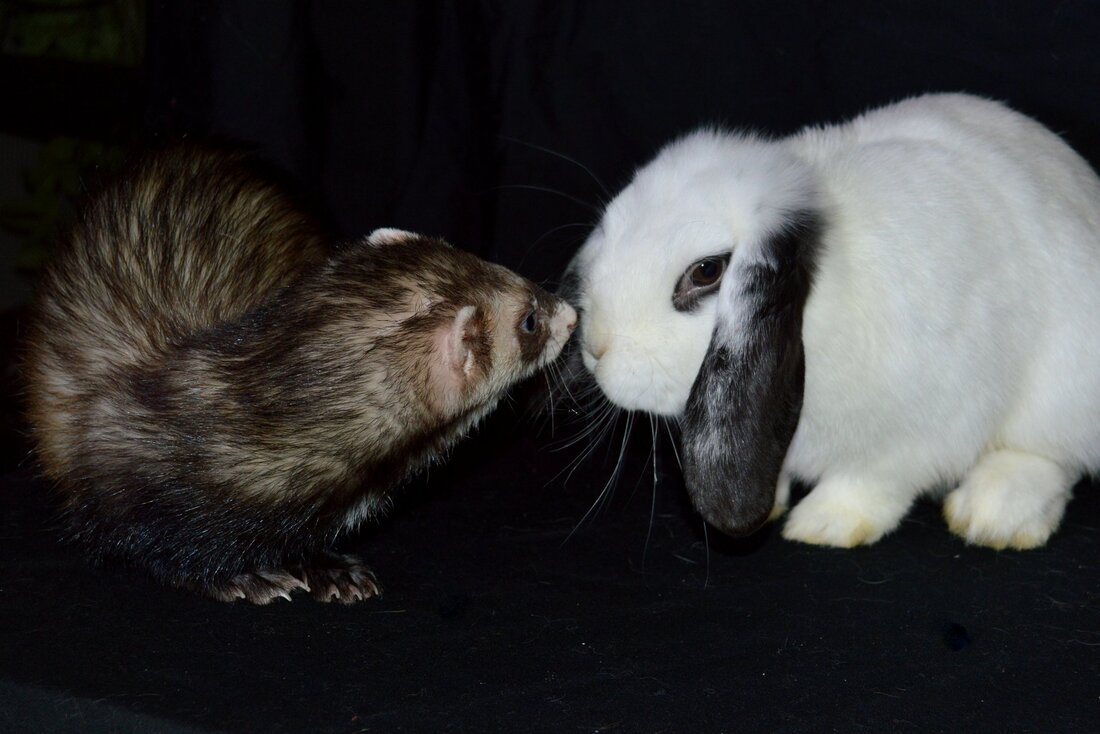|
We often get asked about whether it is possible to have a pet ferret if you also have a pet bunny, rodent, or parrot in the home. There are many stories about pet ferrets causing injury or even death to other pets, but these accidents are preventable. In this series, we are going to discuss different elements that you should be aware of before you mix a pet ferret with other prey type pets.
This is the first part of this series, during which we are going to discuss the biology and history of the domestic ferret. Ferrets have long bodies with flexible spines which they use for navigating underground tunnels. They are nearsighted as they do not need to see much further than a couple feet in front of them as an animal that would spend most of its time low to the ground or in burrows. Their vision works best in low light conditions and they have a blind spot directly in front of their face. They also do not have great depth perception, which most owners can attest as they witness their ferrets falling off surfaces or misjudging jumps. They primarily rely on their sense of smell and their sense of hearing. They have an excellent ability to locate sounds and they are able to hear sounds in ranges above what humans can hear, similar to dogs. Certain high pitch sounds are known to cause an extreme reaction in some ferrets. It is unknown if their distress is because the sound is similar to a crying kit or if the sound actually causes pain or discomfort in their ears. This is important to keep in mind if you have parrots in your home as some of the sounds that they make can fall into this range. We believe that ferrets were domesticated about 2,500 years ago. They were domesticated about the same time as rabbits and the primary use of ferrets was to assist in hunting rabbits. In Domesticated: Evolution in a Man Made World, Richard Francis discusses in depth about the domestication process of animals such as ferrets. For any animal to be domesticated, it must have an increased toleration of humans and an increased tolerance of its own species. Like ferrets, the ancestors of cats were solitary predators and in the process of domestication cats became more social. Wild polecats, which are the ancestors of ferrets, were also solitary hunters. As a result of the domestication process, ferrets are actually very social and they enjoy the company of other ferrets. Ferrets differ from cats in that their domestication process was likely the result of collaborative hunting similar to dogs. This causes ferrets to be more tolerant of prolonged eye contact with humans, more tuned into human emotional states, and better able to respond to human cues in tasks such as finding hidden pieces of food. While ferrets’ original jobs with humans involved controlling rabbit populations and hunting rabbits, they have been trained to perform a variety of tasks such as running wire cables in Buckingham palace for the wedding of Prince Charles and Princess Diana. Ferrets are very gentle and affectionate compared to their wild counterparts, but they still share a lot of DNA in common with their more viscous relatives. It can be hard to imagine a sweet cuddly ferret being a cold hearted murderer, but that is part of their genes. However, years of domestication has delayed the expression of this behavior. Even ferrets that are used to hunting rabbits have this delay as hunters prefer that the rabbit be chased out of the burrow and caught with netting or shot by the hunter rather than have the ferret kill the rabbit in the burrow, requiring the additional task of locating the ferret and digging them out. The drive to kill is blunted, but not absent. They all keep this predatory script in their bodies, but it is usually latent and only comes to the surface with certain triggers. The same is true of dogs and cats. When this script is engaged, we call that predatory drift. For example, a pet dog that kills a stray cat likely experienced predatory drift. When you keep a prey type animal in your home, the ferret can be triggered by the scent, sounds, or movements of the animal. Combined with the fact that most cages are not built to keep ferrets out, this creates the perfect environment for predatory drift to happen and for the other pet to be injured or killed. In the next part of this series we will talk about strategies to keep your other pets safe from your ferret.
1 Comment
|
About the blogFerrets and Friends, LLC has four writers bringing you information on a variety of topics from pets to wildlife, education to conservation, and from new developments in our business to information about our industry. Learn something new each week! Archives
August 2020
Categories
All
|

 RSS Feed
RSS Feed